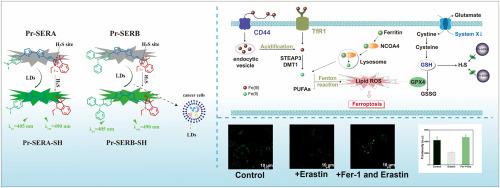Lipid droplet-targeting fluorescent probes for monitoring hydrogen sulfide in ferroptosis
IF 6
2区 化学
Q1 CHEMISTRY, ANALYTICAL
引用次数: 0
Abstract
Background
Ferroptosis represents a unique form of regulated cell death that is distinct from apoptosis, necroptosis, and other modalities. It is characterized by iron-dependent lipid peroxidation and the depletion of glutathione (GSH). Hydrogen sulfide (H2S), a key endogenous gaseous signaling molecule, plays an essential role in various biological and physiological processes. However, owing to the lack of advanced monitoring techniques, elucidating the dynamic fluctuations of H2S during ferroptosis has posed significant challenges for researchers.
Results
In this study, we designed and synthesized two lipid droplet-targeting fluorescent probes (Pr-SERA and Pr-SERB) to investigate the dynamic changes of H2S during ferroptosis. The results indicated that these probes possess high specificity, enabling effective monitoring of H2S concentration fluctuations. Specifically, in the Erastin-induced cell model, a gradual decrease in fluorescence intensity was observed; in contrast, Fer-1-treated cells exhibited a significant increase in fluorescence intensity. This observation aligns with the mechanism by which Erastin suppresses H2S production via the depletion of intracellular GSH, thereby further validating the progressive decline of H2S levels during ferroptosis. Moreover, these probes demonstrated excellent detection performance in zebrafish in vivo models, confirming their suitability and reliability for biological applications. Overall, the fluorescent probes developed in this study serve as valuable tools for elucidating the mechanisms of active molecules involved in ferroptosis.
Significance
It is anticipated that the methodology developed in this investigation will provide a comprehensive and robust analytical tool for the accurate, in-situ quantification of H2S. This approach holds significant promise for advancing the understanding of ferroptosis and its associated disorders.


脂滴靶向荧光探针监测铁下垂硫化氢
背景:铁下垂是一种独特的调节细胞死亡形式,不同于细胞凋亡、坏死下垂和其他形式。它的特点是铁依赖性脂质过氧化和谷胱甘肽(GSH)的消耗。硫化氢(H2S)是一种重要的内源性气体信号分子,在多种生物生理过程中发挥着重要作用。然而,由于缺乏先进的监测技术,阐明铁下垂过程中H2S的动态波动给研究人员带来了重大挑战。结果本研究设计并合成了两种脂滴靶向荧光探针(Pr-SERA和pr -塞族),用于研究铁下垂过程中H2S的动态变化。结果表明,这些探针具有高特异性,能够有效监测H2S浓度波动。具体来说,在erastin诱导的细胞模型中,观察到荧光强度逐渐降低;相比之下,fe -1处理的细胞荧光强度显著增加。这一观察结果与Erastin通过消耗细胞内GSH抑制H2S产生的机制一致,从而进一步证实了铁死亡期间H2S水平的逐渐下降。此外,这些探针在斑马鱼体内模型中表现出优异的检测性能,证实了它们在生物学应用中的适用性和可靠性。总之,本研究中开发的荧光探针为阐明参与铁下垂的活性分子的机制提供了有价值的工具。预计本研究中开发的方法将为准确、原位定量H2S提供全面、可靠的分析工具。这种方法对于推进对铁下垂及其相关疾病的理解具有重要的意义。
本文章由计算机程序翻译,如有差异,请以英文原文为准。
求助全文
约1分钟内获得全文
求助全文
来源期刊

Analytica Chimica Acta
化学-分析化学
CiteScore
10.40
自引率
6.50%
发文量
1081
审稿时长
38 days
期刊介绍:
Analytica Chimica Acta has an open access mirror journal Analytica Chimica Acta: X, sharing the same aims and scope, editorial team, submission system and rigorous peer review.
Analytica Chimica Acta provides a forum for the rapid publication of original research, and critical, comprehensive reviews dealing with all aspects of fundamental and applied modern analytical chemistry. The journal welcomes the submission of research papers which report studies concerning the development of new and significant analytical methodologies. In determining the suitability of submitted articles for publication, particular scrutiny will be placed on the degree of novelty and impact of the research and the extent to which it adds to the existing body of knowledge in analytical chemistry.
 求助内容:
求助内容: 应助结果提醒方式:
应助结果提醒方式:


